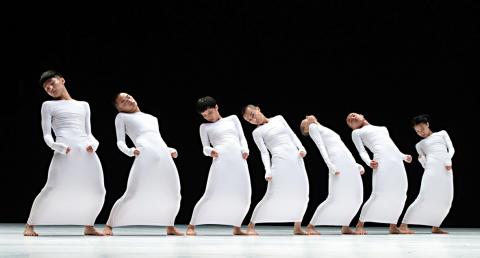The TAO Dance Theater (陶身體劇場) is only nine years old, but it quickly developed a major reputation in China and internationally for its groundbreaking avant-garde, minimalistic works.
Choreographer Tao Ye’s (陶冶) choreography strips dance of its individuality and fripperies, including titling his works simply by the numbers of dancers used, and emphasizes uniformity.
Yet there is a method in his madness — the patterns he weaves are beautiful and the dancers’ physicality and stamina are awe-inspiring.

Photo: Courtesy of TAO Dance Theater
The company made its Taipei debut in March 2014 at Novel Hall, performing 2, 4, 5 and 6, as part of the long-running Novel Hall Dance Series curated by Cloud Gate Dance Theatre (雲門舞集) artistic director Lin Hwai-min (林懷民). TAO has been invited back to perform at Lin’s own theater in New Taipei City’s Tamsui District (淡水) at the beginning of next month, and tickets have been going fast.
It will present a monochromatic double bill of 6 and 7: the former is very dark — in lighting, costume and mood, while the latter is glaringly white.
■ June 9 at 8pm, June 10 and June 11 at 3pm at the Cloud Gate Theater (淡水雲門劇場), 36, Ln 6, Zhongzheng Rd Sec 1, Tamsui District, New Taipei City (新北市淡水區中正路一段6巷36號)
■ There are less than 40 seats left for the June 9 show, at NT$1,400 and about 70 seats at the NT$1,600 price range left each of the other two shows; available online at www.artsticket.com.tw, at convenience store ticketing kiosks and at the door.

May 26 to June 1 When the Qing Dynasty first took control over many parts of Taiwan in 1684, it roughly continued the Kingdom of Tungning’s administrative borders (see below), setting up one prefecture and three counties. The actual area of control covered today’s Chiayi, Tainan and Kaohsiung. The administrative center was in Taiwan Prefecture, in today’s Tainan. But as Han settlement expanded and due to rebellions and other international incidents, the administrative units became more complex. By the time Taiwan became a province of the Qing in 1887, there were three prefectures, eleven counties, three subprefectures and one directly-administered prefecture, with

It’s an enormous dome of colorful glass, something between the Sistine Chapel and a Marc Chagall fresco. And yet, it’s just a subway station. Formosa Boulevard is the heart of Kaohsiung’s mass transit system. In metro terms, it’s modest: the only transfer station in a network with just two lines. But it’s a landmark nonetheless: a civic space that serves as much more than a point of transit. On a hot Sunday, the corridors and vast halls are filled with a market selling everything from second-hand clothes to toys and house decorations. It’s just one of the many events the station hosts,

Two moves show Taichung Mayor Lu Shiow-yen (盧秀燕) is gunning for Chinese Nationalist Party (KMT) party chair and the 2028 presidential election. Technically, these are not yet “officially” official, but by the rules of Taiwan politics, she is now on the dance floor. Earlier this month Lu confirmed in an interview in Japan’s Nikkei that she was considering running for KMT chair. This is not new news, but according to reports from her camp she previously was still considering the case for and against running. By choosing a respected, international news outlet, she declared it to the world. While the outside world

Through art and storytelling, La Benida Hui empowers children to become environmental heroes, using everything from SpongeBob to microorganisms to reimagine their relationship with nature. “I tell the students that they have superpowers. It needs to be emphasized that their choices can make a difference,” says Hui, an environmental artist and education specialist. For her second year as Badou Elementary’s artist in residence, Hui leads creative lessons on environmental protection, where students reflect on their relationship with nature and transform beach waste into artworks. Standing in lush green hills overlooking the ocean with land extending into the intertidal zone, the school in Keelung